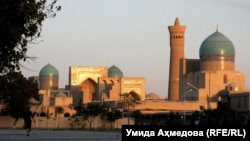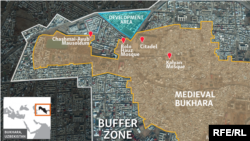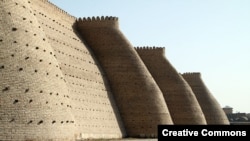If your country boasted one of the most complete examples of a medieval Islamic city in the world, brimming with architectural wonders and rich history owing to its ancient splendor, how would you go about selling it as a tourist attraction to foreigners?
Uzbekistan, if things go according to a draft development plan for the city of Bukhara, would develop a glitzy new tourist zone in an area specifically intended to serve as a buffer to keep modern construction from intruding on the UNESCO-protected city center.
The plans, obtained by RFE/RL, show that "Ancient Bukhara" tourist zone would abut the northwestern side of the city's earthen citadel, whose origins date to the 5th century AD.Replete with modern hotels, health spas, shops, and a 500-capacity amphitheater, the project would require the demolition of a central market that stood along the ancient Silk Road and the possible razing of scores of houses across 10 hectares within the UNESCO buffer zone.
According to a decree on "accelerated development of tourism" in Bukhara, signed on May 19 by President Shavkat Mirziyaev, the project would be financed by the Uzbek National Bank, along with "direct investments and charity" from the Uzbek-born Russian business magnate Alisher Usmanov.
The plans have raised concerns that what UNESCO calls Bukhara's "outstanding universal value" could be at risk, potentially leading the UN agency to revoke the city's coveted status as a World Heritage site.
"The whole point of the project is to attract more foreign tourists," one regional official told RFE/RL, speaking on condition of anonymity out of concern that he could face retaliation. "If we lose Bukhara's UNESCO World Heritage status, then who will want to come to Bukhara?"
Powerful Investor
An official with the National Bank, who was not authorized to speak about the tourism development project, told RFE/RL that the size of the initiative depends on the amount of money Usmanov is willing to invest and contribute through charities.
Usmanov was listed in 2013 by Bloomberg Business News as the 37th richest person in the world, with a net worth of $19.6 billion.
He is the majority shareholder of a Russian industrial conglomerate called Metalloinvest, whose public relations office declined to comment on precise details of the plan and told RFE/RL that Usmanov's spokesman was not available to answer questions about the project.
A culture official in Bukhara, who requested anonymity because he was not authorized to speak about the plan, confirmed that authorities were considering the demolition of up to 96 houses.
The government in Tashkent says a decision will be made by the end of July about which houses will be demolished to make way for the new tourism zone.
Residents in the proposed demolition zone were informed at a public meeting recently that they may be evicted, but none have been told that their house is definitely listed for demolition.
It also remains unclear what amount of compensation would be paid to evicted residents or where such funds would come from.
Intact Medieval City
Bukhara, a city on the ancient Silk Route that is more than 2,000 years old, was inscribed in 1993 by UNESCO as a World Heritage Cultural site.
UNESCO says it is "the most complete example of a medieval city in Central Asia," calling it "one of the best examples of well-preserved Islamic cities of Central Asia of the 10th to 17th centuries, with an urban fabric that has remained largely intact."
It says monuments of particular interest in Bukhara include the tomb of Ismail Samani, "a masterpiece of 10th-century Muslim architecture," and a large number of 17th-century madrasahs.
Bukhara Photo Gallery (click on image to open)
Also notable, UNESCO says, is the 11th-century Poi-Kalyan minaret, "a masterpiece of decoration in brick," along with the Mogoki Attori mosque and the Chashma Ayub shrine.
But UNESCO says that "the real importance of Bukhara lies not in its individual buildings but rather in its overall townscape."
"Modern buildings have been erected in the historic center over the past half-century that have destroyed the appearance of some quarters, but in others the medieval townscape has survived," the UN agency says.
UNESCO also has warned that "urban development pressures resulting in inappropriate designs of new structures" have the potential to negatively affect the authenticity of Bukhara's ancient city center.
Past Mistakes
UNESCO officials were horrified by a tourism development plan in Uzbekistan's southeastern city of Shahrisabz that was overseen by Mirziyaev in 2014 and 2015 when he was prime minister.
That plan led to the bulldozing of a 2-kilometer, 70-hectare swath through the heart of Shahrisabz's UNESCO-listed medieval residential quarters -- replacing it with what Feng Jing, head of UNESCO's Asia-Pacific unit, described as a "modern theme park with tourist kiosks."
As a result, the UN agency has listed Shahrisabz's contribution to world culture as "endangered."
UNESCO's World Heritage Committee is expected at a July meeting in Krakow, Poland, to vote on whether to revoke Shahrisabz's World Heritage status.
An official in the historic preservation department of Uzbekistan's Culture Ministry told RFE/RL that the government made a tragic mistake when it bulldozed Shahrisabz without properly consulting UNESCO experts.
Uzbekistan's Culture Ministry says authorities in Tashkent are now involved in detailed consultations with UNESCO on all aspects of the Bukhara project.
It said new buildings in the UNESCO buffer zone would not be taller than three stories, and would adhere to traditional aesthetics.
A member of a special commission set up to implement Bukhara's tourism development plan also told RFE/RL that every step is being taken to consult UNESCO and ensure compliance with its criteria on the preservation of culture and heritage.
But Feng, the head of the Asia-Pacific unit of UNESCO's World Heritage Center, told RFE/RL on June 2 that he had not heard about the details of Mirziyaev's recent decree until informed about the project by RFE/RL, and that his organization has not "so far received the precise documentation" from Uzbekistan's government.
"If a state party wants to carry out any projects, they should inform the World Heritage Committee – which is an intergovernmental decision-making body," Feng said. "We are the secretariat to the World Heritage Committee. So I think there are clearly defined rules and procedures in the framework of the World Heritage Convention."
Meanwhile, regional cultural officials who have closely studied Mirziyayev's plans for Bukhara told RFE/RL that some aspects of the draft project closely resemble the Shahrisabz fiasco.
Uzbek government officials told RFE/RL that they expect to meet in Uzbekistan in June with a visiting delegation of UNESCO experts to discuss the status of all UNESCO-listed World Heritage sites in the country.
But Feng, who has headed previous visits to Uzbekistan by teams of UNESCO experts, told RFE/RL that he was also not aware of any plans for visits to Uzbekistan in June by UNESCO experts.




